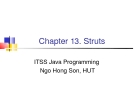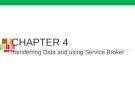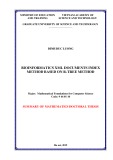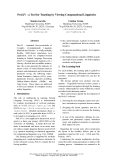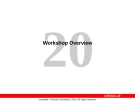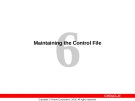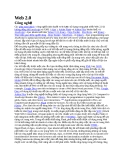
Using xml
-
Describe the necessity and the advantage of the framework Develop the Web application by using the framework. Struts: The Apache Software Foundation JSF (JavaServer Faces): The Java Community Process(JCP) Webcoordinator: FUJITSU Ltd.Framework to develop the Web app. by using Servlet and JSP. Starts according to the request from a client Offers the mechanism to process request, storage of data, screen transition control, etc. Defines screen transition information in XML file (strutsconfig. xml)...
 66p
66p  nguyenvanhabk1
nguyenvanhabk1
 04-09-2012
04-09-2012
 107
107
 20
20
 Download
Download
-
Bài giảng Cơ sở dữ liệu nâng cao - Chapter 4: Transferring data and using service broker. Nội dung chính trong chương này gồm có: Introduction, performing a bulk load, performing a bulk insert task, importing bulk XML data, overview of SQL server integration services, using the import/export wizard, service broker.
 45p
45p  nomoney10
nomoney10
 05-04-2017
05-04-2017
 74
74
 9
9
 Download
Download
-
Research indexing method based on R-tree method to increase the efficiency of XPath queries on XML data, through intermediate data converted into numerical coordinates of tags; use the method of converting XML structured text data into numeric data that can be represented on 2-dimensional space (can be extended to many dimensions).
 26p
26p  capheviahe26
capheviahe26
 25-01-2021
25-01-2021
 20
20
 4
4
 Download
Download
-
ProLiV - Animated Process-modeler of Complex (Computational) Linguistic Methods and Theories - is a fully modular, flexible, XML-based stand-alone Java application, used for computer-assisted learning in Natural Language Processing (NLP) or Computational Linguistics (CL).
 4p
4p  hongphan_1
hongphan_1
 15-04-2013
15-04-2013
 65
65
 4
4
 Download
Download
-
After completing this lesson, you should be able to do the following: Use the Oracle tuning methodology to diagnose and resolve performance problems Use Oracle tools to diagnose performance problems Understand the goals of the workshop
 14p
14p  trinh02
trinh02
 28-01-2013
28-01-2013
 72
72
 5
5
 Download
Download
-
After completing this lesson, you should be able use the following datetime functions: TZ_OFFSET CURRENT_DATE CURRENT_TIMESTAMP LOCALTIMESTAMP DBTIMEZONE SESSIONTIMEZONE EXTRACT FROM_TZ TO_TIMESTAMP TO_TIMESTAMP_TZ TO_YMINTERVAL
 20p
20p  trinh02
trinh02
 28-01-2013
28-01-2013
 51
51
 3
3
 Download
Download
-
Users and Security Security domain The database administrator defines the names of the users who are allowed to access a database. A security domain defines the settings that apply to the user. Authentication mechanism A user who requires access to the database can be authenticated by one of the following: Data dictionary Operating system Network The means of authentication is specified at the time the user is defined in the database and can be altered later. This lesson covers authentication by database and by operating system only.
 20p
20p  trinh02
trinh02
 28-01-2013
28-01-2013
 83
83
 3
3
 Download
Download
-
After completing this lesson, you should be able to do the following: Monitor and size the redo log buffer Monitor and size the Java pool Control the amount of Java session memory used by a session
 16p
16p  trinh02
trinh02
 28-01-2013
28-01-2013
 52
52
 5
5
 Download
Download
-
Control File The control file is a small binary file necessary for the database to start and operate successfully. Each control file is associated with only one Oracle database. Before a database is opened, the control file is read to determine whether the database is in a valid state to use. A control file is updated continuously by the Oracle server during database use, so it must be available for writing whenever the database is open. The information in the control file can be modified only by the Oracle server; no database administrator or end user can edit the control file....
 16p
16p  trinh02
trinh02
 28-01-2013
28-01-2013
 61
61
 3
3
 Download
Download
-
Built-In Database Objects In addition to creating the database files, several other structures are created. Data dictionary: Contains descriptions of the objects in the database Dynamic performance tables: Contains information used by the database administrator (DBA) to monitor and tune the database and instance PL/SQL packages: Program units adding functionality to the database. These packages are created when the catproc.sql script is run after the CREATE DATABASE command. PL/SQL packages will not be discussed within the scope of this course.
 20p
20p  trinh02
trinh02
 28-01-2013
28-01-2013
 66
66
 4
4
 Download
Download
-
Before a database is created, the UNIX environment must be configured and the Oracle9i server must have already been installed. Four environment variables must be set: ORACLE_HOME, ORACLE_SID, PATH, LD_LIBRARY_PATH. ORACLE_HOME is the full path to the top directory in which the Oracle9i Server is installed. The directory for ORACLE_HOME should be supplied by the person who installed the server, usually the UNIX administrator or the DBA. ORACLE_SID is a user-definable name assigned to an instance of a database.
 10p
10p  trinh02
trinh02
 28-01-2013
28-01-2013
 63
63
 6
6
 Download
Download
-
Course Objectives This course is the first in a series of courses that cover the core database administrator tasks. The tasks covered in this course are: Outlining the Oracle architecture Planning and creating databases Managing the memory, process, physical, and logical structures Managing database users by controlling and monitoring their actions Using the Globalization Support features
 4p
4p  trinh02
trinh02
 28-01-2013
28-01-2013
 63
63
 4
4
 Download
Download
-
Cross Checks of RMAN Backups and Copies Performing a cross check provides you with a way to ensure that data about backup sets and image copies in the RMAN repository is synchronized with corresponding data on disk or in the media management catalog. You can use the LIST command to obtain a report of the backups and copies that you have made and then use the CROSSCHECK command to check that these files still exist. If RMAN cannot find a file, it updates the repository records to EXPIRED. You can determine which files are marked EXPIRED by issuing a LIST EXPIRED command....
 18p
18p  trinh02
trinh02
 28-01-2013
28-01-2013
 49
49
 5
5
 Download
Download
-
Using Oracle Enterprise Manager You can use the Recovery Wizard to restore and recover your database. On the Range Selection page you must enter a date and time to restore to a previous point. You use Instance Management or the Console to open the database after the job has completed. You can view the status of the job by selecting the Active and History page tabs in the Console’s Job window.
 12p
12p  trinh02
trinh02
 28-01-2013
28-01-2013
 51
51
 4
4
 Download
Download
-
Restoration and Datafile Media Recovery Using RMAN RMAN automates the procedure for restoring files. When you issue the RESTORE command, RMAN uses a server session to restore the correct backups and copies. The RMAN repository is used to select the best available backup set or image copies to use in the restoration. By default, RMAN does not restore a file if the file is already in the correct place and its header contains the correct information. In releases before Oracle9i, the files were always restored.
 16p
16p  trinh02
trinh02
 28-01-2013
28-01-2013
 58
58
 7
7
 Download
Download
-
In either case, the easiest way is to drop the entire tablespace that contains the datafile. The steps that are to be executed from within SQL*Plus are: 1. STARTUP MOUNT 2. For each deleted datafile, issue the command ALTER DATABASE DATAFILE ’full path of filename’ OFFLINE [DROP]; Note: You must use the DROP option if the database is in NOARCHIVELOG mode, because you cannot recover this file if you apply incomplete media recovery on it via the command ALTER DATABASE OPEN RESETLOGS. See the SQL Reference for details. 3. ALTER DATABASE OPEN; 4.
 14p
14p  trinh02
trinh02
 28-01-2013
28-01-2013
 54
54
 4
4
 Download
Download
-
Các phía máy khách / công nghệ trình duyệt web được sử dụng trong phát triển Web 2.0 là không đồng bộ JavaScript và XML ( Ajax ), Adobe Flash và Adobe Flex khuôn khổ, và JavaScript / Ajax khuôn khổ như Yahoo! UI Library , Dojo Toolkit , MooTools , and jQuery . Thư viện giao diện người dùng , Dojo Toolkit , MooTools , và jQuery . Ajax programming uses JavaScript to upload and download new data from the web server without undergoing a full page reload. lập trình Ajax sử dụng JavaScript để tải lên và tải về dữ liệu mới từ...
 12p
12p  qh3131988
qh3131988
 22-09-2011
22-09-2011
 196
196
 40
40
 Download
Download
-
Sử dụng SQL Server FOR XML khoản Với một tuyên bố tiêu chuẩn SELECT SQL, bạn gửi câu lệnh SELECT của bạn vào cơ sở dữ liệu để thực hiện và nhận được kết quả trở lại dưới hình thức hàng. SQL Server mở rộng các câu lệnh SELECT để cho phép bạn truy vấn cơ sở dữ liệu và nhận được kết quả lại như XML. Để làm điều này, bạn thêm một FOR XML khoản vào cuối câu lệnh SELECT của bạn. ...
 12p
12p  hamberger5k
hamberger5k
 08-08-2010
08-08-2010
 101
101
 13
13
 Download
Download
-
Bạn sử dụng một đối tượng của lớp XmlDocument để đại diện cho một tài liệu XML trong một chương trình C #. Một đối tượng XmlDocument cửa hàng các nút của các tài liệu XML trong các đối tượng của lớp XmlNode. Bạn có thể, ví dụ, dòng tải từ cơ sở dữ liệu vào một đối tượng DataSet, và sau đó tải một đại diện XML của những người hàng vào một đối tượng XmlDocument. Bảng 16,5 cho thấy một số tài sản XmlDocument...
 8p
8p  hamberger5k
hamberger5k
 08-08-2010
08-08-2010
 105
105
 10
10
 Download
Download
-
Đó là nơi mà các lớp XmlDataDocument có in Bạn sử dụng một đối tượng của lớp XmlDataDocument để hàng truy cập như là cả hai đối tượng XmlNode và các đối tượng DataRow quan hệ. Bạn kết hợp một DataSet với XmlDataDocument của bạn bằng cách đi qua DataSet của bạn vào constructor XmlDataDocument. Một đối tượng XmlDataDocument cung cấp đồng bộ hóa giữa DataSet và tài liệu XML. Ví dụ, nếu bạn thêm một khách hàng mới là một đối tượng XmlNode để XmlDataDocument của bạn...
 6p
6p  hamberger5k
hamberger5k
 08-08-2010
08-08-2010
 75
75
 5
5
 Download
Download
CHỦ ĐỀ BẠN MUỐN TÌM








